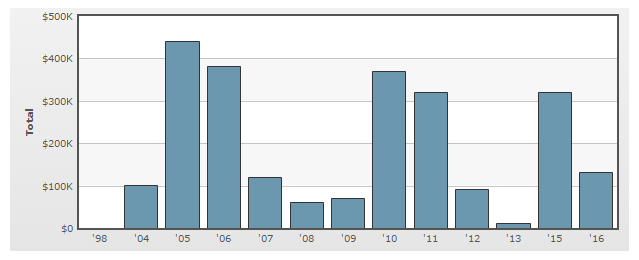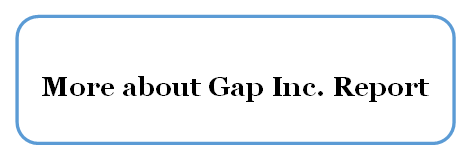Gap Inc. PESTEL Analysis: Social Changes as the Main Driver of the Business
PESTEL is a strategic analytical tool and the acronym stands for political, economic, social, technological, environmental and legal factors. Gap Inc. PESTEL analysis refers to the analysis of potential impact of above external factors on the bottom line and long-term growth prospects of the business.
Political Factors
There is a set of political factors such as political stability in the market, relevance of bureaucracy and corrupt practices, the freedom of press, home market lobbying practices and others that can affect Gap Inc. in multiple levels. The company is engaged in lobbying its political interests. However, as it is illustrated in figure below, Gap Inc. annual lobbying budget is not fixed and it fluctuates significantly year by year to reflect specific political issues the business wants to address each year.
Gap Inc. annual lobbying budget[1]
Gap Inc. has also been involved in a political controversy and has been accused of causing racial controversy to get spectacular press coverage and social visibility. The company’s Twitter campaigns included an image of “two white girls in poses that look quite painful, next to a third white girl using a smaller black girl as an armrest”[2] The campaign caused a massive controversy and debate attracting thousands of retweets and likes, the story being covered by more than 214 news articles.[3] Another instance of Gap marketing campaign involved an image of a happy interracial family, causing debates on social media platforms about the issue of interracial marriage.
Economic Factors
Gap Inc. market share and revenues are affected by a great range of economic factors directly or indirectly. Changes in foreign exchange rate is one of the major economic factors that have direct implications on Gap’s financial performance. For example, the company’s net sales for fiscal 2015 decreased USD 638 million, or 4 percent, compared with fiscal 2014 primarily due to the unfavorable impact of foreign exchange of about USD 363 million.[4] The negative effect of foreign exchange was primarily caused by the weakening of the Canadian dollar and Japanese yen against the U.S. dollar.
An additional range of factors such as changes in inflation rate and tax rate in the US, the rate of unemployment, the cost of labor, changes in consumer disposable income and others can also affect the performance Gap Inc. in the US and international markets…
Gap Inc. Report contains the full discussion of Gap Inc. PESTEL analysis. The report also illustrates the application of the major analytical strategic frameworks in business studies such as SWOT, Porter’s Five Forces, Value Chain analysis and McKinsey 7S Model on Gap Inc. Moreover, the report contains analysis of Gap Inc.’s marketing strategy, its leadership and organizational structure and discusses the issues of corporate social responsibility.
[1] Open Secrets (2016) Available at: https://www.opensecrets.org/lobby/clientsum.php?id=D000000547 s
[2] Shuptrine, C. (2016) “Is Gap Inc Exploiting Racial Tension to Raise Brand Awareness?” The Huffington Post, Avilable at: http://www.huffingtonpost.com/chris-shuptrine/is-gap-exploiting-racial-_b_9839818.html
[3] Shuptrine, C. (2016) “Is Gap Inc Exploiting Racial Tension to Raise Brand Awareness?” The Huffington Post, Avilable at: http://www.huffingtonpost.com/chris-shuptrine/is-gap-exploiting-racial-_b_9839818.html
[4] Annual Report (2015) GAP Inc.


